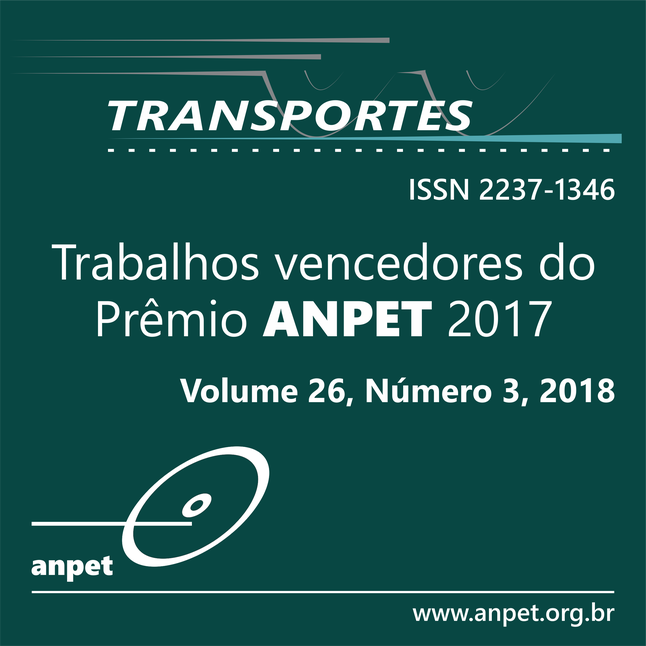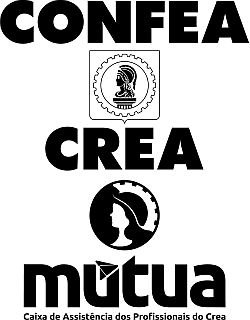Calibração do modelo de aceitação de brechas em interseções urbanas com o microssimulador de tráfego VISSIM
DOI:
https://doi.org/10.14295/transportes.v26i3.1603Palavras-chave:
Interseções não semaforizadas, Aceitação de brechas, Brecha crítica, Simulação microscópica, Calibração.Resumo
Este artigo tem como objetivo principal propor um método para a modelagem do processo de aceitação de brechas em interseções urbanas não semaforizadas utilizando o microssimulador VISSIM. O método proposto tem como medida-alvo o tempo que o motorista leva no processo de avaliação das brechas, ou seja, o tempo de espera enquanto está na primeira posição da fila. O c2 da aderência entre as distribuições dos tempos de espera (simulados e observados) e a diferença entre as médias foram utilizados na estimação da brecha crítica. O método foi aplicado em uma interseção da cidade de Fortaleza. Os resultados indicaram valores levemente diferentes da brecha crítica entre os movimentos de conversão. O segundo objetivo deste trabalho é comparar o método proposto com o método de calibração mais convencional, no qual a medida-alvo é uma medida de desempenho do tráfego, como o tamanho médio da fila. O método proposto apresentou melhores resultados.
Downloads
Referências
Brilon, W.; R. Koenig e R. J. Troutbeck (1999) Useful estimation procedures for critical gaps. Transportation Research Part A: Policy and Practice, v. 33, n. 3-4, p. 161-186. DOI:10.1016/S0965-8564(98)00048-2.
Depiante, V. S. e J. J. Galarraga (2012) Intervalos Criticos y Capacidad en Intersecciones no Semaforizadas de Tres Ramas. Congreso Panamericano de Ingeniería de Tránsito, Transporte y Logística, PANAM, Santiago, Chile.
Elefteriadou, L. (2014) An Introduction to Traffic Flow Theory. Ed. Springer, New York. DOI:10.1007/978-1-4614-8435-6.
Garber, N. J. e L. A. Hoel (2015) Traffic and Highway Engineering. 5. Ed. CL Engineering.
Jie, L.; H. V. Zuylen; Y. Chen; F. Viti e I. Wilmink (2013) Calibration of a Microscopic Simulation Model for Emission Calculation. Transportation Research Part C: Emerging Technologies, v. 31, n. 0, p. 172-184. DOI:10.1016/j.trc.2012.04.008.
Kyte, M.; M. Dixon e P. M. Basavaraju (2003) Why Field Measurements Differ from Model Estimates. Transportation Research Record: Journal of the Transportation Research Board, v. 1852, p. 32-39. DOI:10.3141/1852-05.
Lacerda, V. M. e M. M. Castro-Neto (2014) Considerações sobre a Calibração do Modelo de Car-following do VISSIM para Vias Arteriais Urbanas. Anais do XXVIII Congresso de Pesquisa e Ensino em Transportes, ANPET, Curitiba.
Lacerda, V. M. (2016) Estimação da Velocidade Média em Vias Urbanas com Uso do Microssimulador VISSIM. Dissertação (Mes-trado em Engenharia de Transportes). Programa de Pós-Graduação em Engenharia de Transportes, Universidade Fede-ral do Ceará, Fortaleza, CE.
Lidbe, A. D.; A. M. Hainen e S. L. Jones Jr. (2016) Comparative Study of Simulated Annealing and Genetic Algorithm for Cali-bration of Microsimulation Model. In: Transportation Research Board 95th Annual Meeting, Washington, USA.
Liu, P.; X. Q. H. Yu; W. Wang e B. Cao (2012) Development of a VISSIM Simulation Model for U-Turns at Unsignalized Intersec-tions. Journal of Transportation Engineering, v. 138, n.11, p. 1333-1339. DOI:10.1061/(ASCE)TE.1943-5436.0000438.
Martin-Gasulla, M.; A. García e C. Llorca (2017) Headway Acceptance Decisions on Single-Lane Roundabouts in Spain. Critical and Follow Headway. In: Transportation Research Board 96th Annual Meeting, Washington, USA.
Mohan, M. e S. Chandra (2016) Influence of Major Stream Composition on Critical Gap at Two-Way Stop-Controlled Intersec-tions. In: Transportation Research Board 95th Annual Meeting, Washington, USA.
PTV (2016) VISSIM 9.0. Manual do Usuário. Plannung Transport Verkehr AG, Karlsruhe, Germany.
Raff, M. S. (1950) A Volume Warrant for Urban Stop Signs. Eno Foundation for Highway Traffic Control, Saugatuck, Connecti-cut.
Tarko, A. e Z. Tian (2003) Example Analysis and Handling of Uncertainty in the Highway Capacity Manual with Consideration of Traffic Diversion. Transportation Research Record: Journal of the Transportation Research Board, v. 1852, p. 40-46. DOI:10.3141/1852-06.
TRB (2010) Highway Capacity Manual. Transportation Research Board, v. 3, Washington.
Viti, F.; B. Wolput; C. M. J. Tampère e P. Vandervelden (2013) Dynamic Modeling of VISSIM’s Critical Gap Parameter at Un-signalized Intersections. Transportation Research Record: Journal of the Transportation Research Board, v. 2395, p. 12-20. DOI:10.3141/2395-02.
Downloads
Publicado
Como Citar
Edição
Seção
Licença
Ao submeter um manuscrito para publicação neste periódico, todos os seus autores concordam, antecipada e irrestritamente, com os seguintes termos:
- Os autores mantém os direitos autorais e concedem à Transportes o direito de primeira publicação do manuscrito, sem nenhum ônus financeiro, e abrem mão de qualquer outra remuneração pela sua publicação pela ANPET.
- Ao ser publicado pela Transportes, o manuscrito fica automaticamente licenciado sob a Licença Creative Commons CC BY 4.0. Esta licença permite o seu compartilhamento com reconhecimento da autoria e da publicação inicial neste periódico.
- Os autores têm autorização para assumir contratos adicionais separadamente, para distribuição não exclusiva da versão do trabalho publicada neste periódico (por ex.: publicar em repositório institucional ou como capítulo de livro), com reconhecimento da publicação inicial na Transportes, desde que tal contrato não implique num endosso do conteúdo do manuscrito ou do novo veículo pela ANPET.
- Os autores têm permissão e são estimulados a publicar e distribuir seu manuscrito online (por ex.: em repositórios institucionais ou na sua página pessoal) depois de concluído o processo editorial. Como a Transportes é de acesso livre, os autores são estimulados a usar links para o DOI do artigo nesses casos.
- Os autores garantem ter obtido a devida autorização dos seus empregadores para a transferência dos direitos nos termos deste acordo, caso esses empregadores possuam algum direito autoral sobre o manuscrito. Além disso, os autores assumem toda e qualquer responsabilidade sobre possíveis infrações ao direito autoral desses empregadores, isentando a ANPET e a Transportes de toda e qualquer responsabilidade neste sentido.
- Os autores assumem toda responsabilidade sobre o conteúdo do manuscrito, incluindo as devidas e necessárias autorizações para divulgação de dados coletados e resultados obtidos, isentando a ANPET e a Transportes de toda e qualquer responsabilidade neste sentido.











